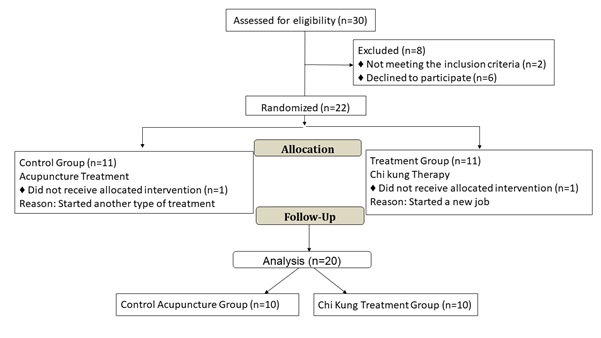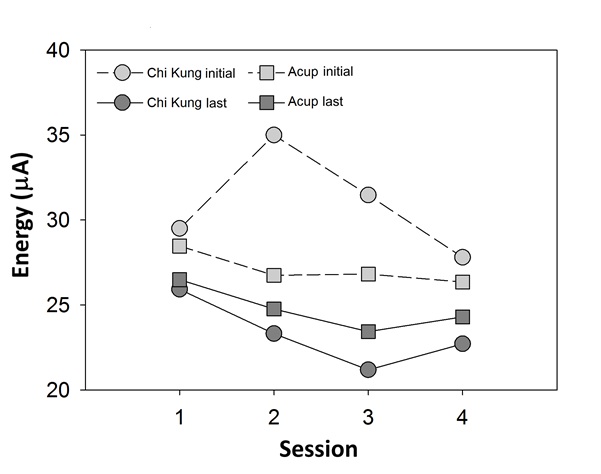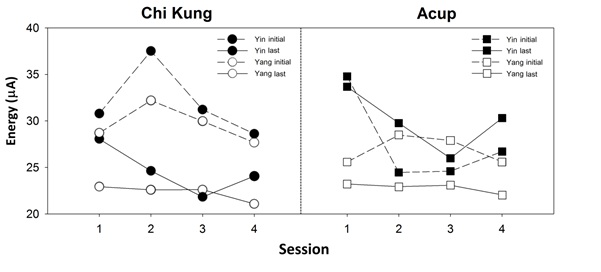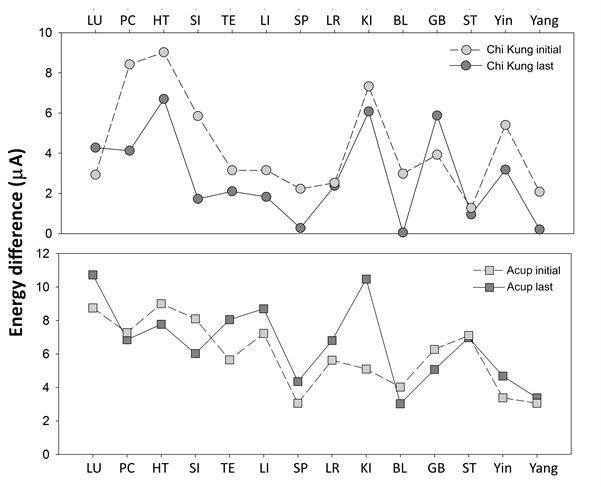
Medical Chi Kung in Energy Balance, Clinical Trial Randomized Study
*Corresponding Author(s):
Sousa Maria Da Luz Rosário DeDepartament Of Health Sciences And Pediatric Dentistry, State Universty Of Campinas, Brazil
Tel:+55 019992799784,
Email:luzsousa@fop.unicamp.br
Abstract
The objective of this study is to evaluate the energy flow promoted by the application of medical Chi Kung therapy, having as comparison a group treated with acupuncture. The sample was 20 adult patients of both sexes, from a larger study, who sought treatment for temporomandibular joint dysfunction. They were divided into two groups: Treatment (patients who received medical Chi Kung therapy) and Control (patients who received acupuncture therapy). Four sessions were held for both groups, with one session per week. Chi Kung application followed a standard protocol. The following acupoints were used in acupuncture group: ST6, ST7, SI18, GV20, GB20, BL10, LI4. Energy measurements were conducted in both groups before and after therapy in all sessions using the Ryodoraku method. The analysis of results showed that the Treatment group presented a decrease in energy values in all meridians after each session with a tendency to equilibrium over the four sessions. The evaluation of the mean values of all meridians found that half showed negative variation and the other six remained stable. There was no statistical difference in the mean of the meridians for the Control group; however, the final mean energy value presented decrease over the four sessions. The use of medical Chi Kung therapy promoted a change in the mean of the energy flow in the meridians and provided energy balance, pattern different from that showed by acupuncture group.
Keywords
Bioelectric Energy Sources; Meridians; Qigong Therapy; Traditional Chinese Medicine
INTRODUCTION
The concept of health for Traditional Chinese Medicine is based on a vital energy (Qi) that flows through channels named meridians that are connected to the main organs. Being healthy depends on the energy level and its balance within the acupuncture meridians [1]. The treatment consists in releasing the flow of Qi to restore the energetic balance through therapeutic techniques such as qigong, acupuncture and others [2].
Chi Kung is an ancient therapy that has been practiced throughout the generations and that has been influenced by Buddhism and Taoism [3]. Chi kung therapy can be divided into Medical Chinese Chi kung, Taoist Chi kung, Buddhist Chi kung, Confucian Chi kung and Martial Arts Chi kung; however, all forms are based on actions that promote the flow of Qi [4].
Medical Chi Kung aims to regain, maintain and develop physical and mental health through the mobilization of Qi [3]. Energy therapy is related to posture (Jing), mind (Shen) and breathing (Chi), for controlling the energy flow of the self or of others. Chi kung’s benefits, especially of the medical variant, are the emotional and energetic detoxification of organs; the strengthening of the mind; the soothing and regulation of Qi meridians by facilitating its flow. The therapy is practiced by professionals who have mastered the technique of directing the energy to relief the suffering of people [5]. The specialized professional directs the energy that can unblock the energy flow and balance it [5]. Another Chinese therapy that seeks to prevent and/or restore health and maintain the free flow of Qi is acupuncture, through the insertion of needles into specific anatomical landmarks called acupoints [6].
Objective measurements such as energy flow analysis can be useful tools during diagnosis, and aid in the assessment of the evolution of the applied therapy. Several instruments can be used to measure the flow of meridians by evaluating the conductance and skin resistance on acupoints [7], one of them is the method developed by Dr. Nakatami in 1947, which consists in measuring the energy flow of the 12 meridians on each side of the body and may represent the Qi level of the meridians. Nakatani organized the electro penetrable points as “Ryodorakus”, which are conductive routes of electricity, whose route turned out to be quite similar to the meridians [8]. Conductivity in acupuncture landmarks is known to be directly proportional to the amperage of direct current flowing through the skin when 12 V are applied to measurement landmarks [9].
Given the discussion above, the objective of this study is to evaluate the energy flow promoted by the application of medical Chi Kung therapy, having as comparison a group treated with acupuncture.
METHODS
This was a clinical study, randomized, controlled and conducted from May 2016 to June 2017 at the Clinic of the School of Dentistry of Piracicaba (FOP/UNICAMP), Piracicaba, SP, Brazil. The study followed all ethical principles foreseen in Law 196/96 of the Brazilian National Health Council of the Ministry of Health. The research started after being approved by the institution’s Research Ethics Committee under the following protocols: no: 099/2008 and no. 109/2014. All patients signed an informed consent form.
Inclusion Criteria
Adults of both sexes aged between 20 to 50 years with Temporomandibular Disorders (TMD) of muscular origin.
Exclusion Criteria
Adults with TMD no muscular origin; patients who were under other therapies; patients with needle phobia and pregnant women.
Randomization
Thirty volunteers from a larger study were evaluated. From these, eight were excluded, two did not met the inclusion criteria and six did not want to participate in the study. Thus, 22 volunteers were randomized in two groups of treatment (Acupuncture and Chi Kung). Two more volunteers quit during the treatment, resulting in a sample of 20 volunteers. Randomization was performed by a researcher who allocated volunteers at random by drawing lots, as shown on the flowchart (Figure 1). The volunteer did not know about the allocation before start the research.
 Figure 1: Sample composition flowchart.
Figure 1: Sample composition flowchart.
Study Groups
Control group: is part of a larger study in which volunteers received acupuncture treatment, which is a method that is already recognized in the literature as effective for TMD treatment [10], by following Rosted’s 2001 protocol (ST6, ST7, SI8, GV20, BL10 and LI4), for four sessions with 20 minutes of duration on average, being held once per week.
Before inserting the needles, the insertion points underwent skin asepsis with 70% alcohol. The needles used were disposable and sterile, individually packed, sized 0.30 × 30 mm and manufactured by Asiamed in Suhl, Germany. The depth of penetration was based on the anatomical differences of each volunteer. The needles were manipulated until achieving DeQi sensation and the needles were left to rest for 20 minutes and then removed.
Treatment Group: underwent the medical Chi Kung therapy for four sessions, once per week, for 20 minutes and following a standard protocol, applied by a single qualified professional.
Description of the standard Chi Kung therapy protocol
The application of the medical Chi Kung technique was conducted by a trained professional and who followed the standard protocol of Johnson [11]. According to Johnson [12], the therapist prepares himself/herself by cleaning the environment through the “Pulling down the Heaven” technique and using 1 to 10 meditation. The therapist dradges the perverse power of the Wei Qi fields (the patient’s defense energy fields) directing the toxic Qi to the vortex (place to forward the perverse energy). Following, the therapist moves his/her right hand next to the patient’s body to feel where there are blocks. The patient’s Taiji Pole is filled with energy, tonifying his/her kidneys by placing his/her hands over their ears. Following, movements to harmonize and tonify the organs are made: patient’s left and then right lung, considering five specific steps. Then, the heart, an area called yellow patio (sternum area), liver, spleen, kidneys, urogenital area and excretory system and finishes by circling the Micro Cosmic Orbit. The three energy fields are then closed. The therapist hands are washed. The therapist goes back to the patient and requests him/her to sit down and gather the energy from the heart and kidneys by making circles on the patient’s back and rooting the energy. All patients underwent four sessions, each lasting 20 minutes.
Study stages
- • Clinical history, clinical examination of the tongue, and pulsology
- • Patient’s position on the dental chair
- • First measurement of the energy flow prior to application of Chi kung or acupuncture in each of the four sessions
- • Application of the treatment techniques (Chi Kung or acupuncture)
- • Second measurement of energy flow in each of the four sessions
3-Outcome
Energy assessment
Energy was measured in all four treatment sessions of every participant in both groups. The protocol comprised two measurements in each session, one conducted before the application of medical Chi Kung or acupuncture, and another after the technique had already been applied.
Ryodoraku’s method was used to obtain the bioenergy graph using the Ryodoraku apparatus (RDK/NKL – Produtos Eletrônicos Ltda. Brusque – SC – Brazil \ lote 00218). This device is a portable unit that connects itself via USB on a specific Samsung core i5 computer. It has two electrodes responsible for capturing the current signal in the patient’s circuit. One of the electrodes is a return probe held by the patient, and the other is a probe that allows the placement of a cotton swab in its end. The cotton swab must be moistened in water, so it can be used to touch the patient’s skin for 1 second, applying a continuous 12 µa current. Based on the Ryodoraku theory, participants who presented energy values between 40 to 60 µa were classified as physiologically normal, having a balanced Qi [8].
The study considered 24 measurement points, with 12 being located on the hands’ fists (left and right): Lung (LU 9), Pericardium (PC 7), Heart (HT 7), Small Intestine (SI 5), Triple Energized (TE 5) and Large Intestine (LI 5). The other 12 are in the ankles/feet (left and right): Spleen Pancreas (SP 3), Liver (LR 3), Kidney (KI 3), Bladder (BL 64), Gallbladder (GB 40), Stomach (ST 42).
Statistical analysis
To calculate energy changes over the four sessions, the mean starting energy of each volunteer (which corresponds to the mean of the 12 pairs of meridians) was compared to the mean final energy of the same volunteer. Yin and Yang energy values were evaluated considering the initial and final mean values of each session. The laterality balance between the left and right meridians was also analyzed. For such comparisons the ANOVA test was applied, 2014 Xlstat version program, considering a p
RESULTS
Energy
The overall mean energy was evaluated in both groups over the four sessions, finding a decrease in the final energy values after each session of medical Chi Kung therapy. This variation was significantly higher in the Treatment group (Chi Kung) when compared to the Control group (acupuncture). However, as can be seen in figure 2, mean energy values were higher when participants from the Treatment group returned for the next session when compared to the initial mean energy from the previous session. By comparing the mean initial energy to the mean final energy after the four sessions we can observe that the Treatment group had significant energy loss in the following meridians: Lung, Pericardium, Small Intestine, Triple Energized, Large Intestine, Liver and Stomach. Energy values were maintained in the meridians: Heart, Spleen Pancreas, Kidney, Bladder and Gallbladder. In the control group, only the Small Intestine meridian presented negative difference and the other meridians maintained their energy (Table 1). Comparative data of Yin initial and final energy means (6 Yin meridians) with Yang initial and final energy means (6 Yang meridians) showed that the Treatment group underwent decrease in both the energies, having Yang meridians as the ones with largest decrease. This difference was not significant in the Control group. Regarding the analysis of the differences in lateralities, we found no statistically significant data in the Treatment group; however, over the four sessions the difference of final laterality was lower in all meridians, except in the Lung and Gallbladder meridians (Figure 3). In the Control group this difference occurred in the Pericardium, Heart, Small Intestine, Bladder, Gallbladder and Stomach meridians; Kidney and Spleen Pancreas meridians presented a statistical increase in laterality difference (Figure 4).
 Figure 2: Initial and final energy means in all four sessions.
Figure 2: Initial and final energy means in all four sessions.
 Figure 3: Variation of Yin and Yang energy in both groups.
Figure 3: Variation of Yin and Yang energy in both groups.
 Figure 4: Laterality difference between the Meridians.
Figure 4: Laterality difference between the Meridians.
 Table 1: Variations of the initial and final mean values (± standard error) of the energy flow in the 12 meridians and Yin and Yang energy over four sessions in both groups.
Table 1: Variations of the initial and final mean values (± standard error) of the energy flow in the 12 meridians and Yin and Yang energy over four sessions in both groups.
DISCUSSION
Chi Kung therapy showed that there was an increase in the mean energy values over the course of the sessions. At the end of treatment it was observed that mean energy values were greater when the patient returned than when the therapy started, corroborating the results of a pilot study conducted by Sanco [13], which showed that the practice of Chi Kung exercises increased the energy means of meridians at the end of exercise practice. These results are also similar to clinical responses found in other studies [4,14,15] that showed that the practice of medical chi kung was effective as an adjuvant therapy to cancer treatments, since, according to the authors, the practice promotes an improvement in patients’ quality of life.
However, there are few studies in the literature that measure the energy flow after Chi Kung therapy to evaluate potential energy changes. Sanco’s clinical study [16] evaluated energy flow measurements after Chi Kung therapy and found that these energy measures, obtained through the Ryodoraku method, indicated the balance of energies of meridian systems after the application of the therapy. Such result is similar to what was found in this study, given the tendency to zero found in the evaluation of the differences between the laterality of the meridians. In a clinical study that used medical and martial arts chi kung on breast cancer patients who were under chemotherapy treatment, Huang4 showed that both groups presented improvements in quality of life; however, the improvements caused by medical Chi kung therapy only occurred after the third month. These clinical responses can be justified because medical Chi Kung therapy involves smooth movements that promote a progressive adjustment of the energy flow [2,17] and according to Perez [8], normal energy flow values are between 40 to 60 µa, allowing the body the ability to self-regulate and self-repair.
Regarding acupuncture, Lin [18] observed that after acupuncture treatment Ryodoraku values decreased significantly in the energy of some meridians after the first session and after the fifth session. In this study, Chi Kung therapy increased the initial mean energy which remained stable until the end of the treatment. With regard to meridians, all presented reduction in energy values, considering four Yang and two Yin meridians, differently than what occurred in acupuncture. We can argue that this change in the energy level was caused by a decrease in the mean energy of Yang meridians, considering that the highest variation occurred in the Treatment group and that there was no statistical difference for the Control group. According to Zotteli [19] this result is expected because Yin energy is denser than Yang energy.
Medical Chi Kung therapy thus seeks to promote the free flow of energy (Qi), and when energy flows it unblocks the channels leading to energy balance, which restores health and prevents diseases [20], preserving biochemical, functional and organic body functions [8].
The limitations of this study were the limited sample number and short collection period. Increasing the number of sessions could demonstrate such energy accumulation more clearly. Additional studies are needed to better elucidate the changes in energy flow promoted by the practice of Medical Chi Kung and the possible consequences for the physical and emotional well being of patients.
CONCLUSION
The use of medical Chi kung therapy promoted a change in the mean of the energy flow in the meridians and provided energy balance, pattern different from that showed by acupuncture group.
ACKNOWLEDGEMENT
The authors would like to thank the undergraduate students (Gabriel NutoNobrega) and former graduate student at the Department of Soil Science of the Luiz de Queiroz College of Agriculture (ESALQ/USP) and Professor Tiago Osório Ferreira, from this very institution, due to his critical participation in data tabulation and analysis.
The authors would also like to thank Espaço da Escrita (UNICAMP) for the language services provided.
REFERENCES
- Nagilla N, Hankey A, Nageandra H (2013) Effects of yoga practice on acumeridian energies: Variance reduction implies benefits for regulation. Int J Yoga 6: 61-66.
- Oh B, Butow P, Mullan B (2008) Medical Qigong for Cancer Patients: Pilot Study of Impact on Quality of Life, Side Effects of Treatment and Inflammation. Am J Chin Med 36: 459-472.
- Livramento G, Franco T, Livramento A (2010) A ginástica terapêutica e preventiva chinesa LianGong/Qi Gong como um dos instrumentos na prevenção e reabilitação da LER/DORT. Rev bras Saúde ocup 35: 74-86.
- Huang S-M, Tseng L-M, Chien L-Y, Tai C-J, Chen P-H, et al. (2016) Effects of non-sporting and sporting qigong on frailty and quality of life among breast cancer patients receiving chemotherapy. Eur J Oncol Nurs 21: 257-265.
- Lee MS, Pittler MH, Ernst E (2007) External Qigong for Pain Conditions: A Systematic Review of Randomized Clinical Trials. J Pain 8: 827-831.
- Sari E, Sari T (2010) The role of acupuncture in the treatment of orthodontic patients with a reflex gagging: pilot study. Br Dent J 208: 19.
- Mist SD, Aickin M, Kalnins P, Cleaver J, Batchelor R, et al. (2011) Reliability of AcuGraph system for measuring skin conductance at acupoints. Acupunct med 29: 221-226.
- Perez ACN (2013) Las Biomediciones Segun El Metodo Ryodoraku: El Diagnostico De Situación Y Su Tratamiento. Ediciones, Madrid, Spain.
- Lee C-T, Chang Y-H, Lin W-Y, Xu J-M, Chen H-Y, et al. (2010) Applications of Meridian Electrical Conductance for Renal Colic: A Prospective Study. J Altern Complement Med 16: 861-866.
- Rosted P (2001) Practical recommendations for the use of acupuncture in the treatment of temporomandibular disorders based on the outcome of published controlled studies. Oral Dis 7: 109- 115.
- Bai L, Yan H, Li L, Qin W, Chen P, et al. (2010) Neural specificity of acupuncture stimulation at pericardium 6: evidence from an FMRI study. J Mag Reson Imaging 31: 71-77.
- Johnson JA (2002) Differential Diagnosis Clinical Foudations Treatament Principles And Clinical Protocols in The Clinical Protocols of Medical Qigong Therapy. The International Institute of Medical Qigong 3: 363-373.
- Sancier KM (1999) Therapeutic Benefits of Qigon Exercises in Combination with Drugs. J Altern Complement Med 5: 383-389.
- Larkey LK, Roe DJ, Smith L, Millstine (2016) Exploratory outcome assessment of Qigong/Tai Chi Easy on breastcancer survivors. Complementary Therapies in Medicine 29: 196-203.
- Oh B, Choi SM, Inarmori A, Rosenthal D, Yeung A (2013) Effects of Qigong on Depression: A Systemic Review. Evid Based Complement Alternat Med 2013: 134737.
- Sancier KM (2003) Electrodermal measurements for monitoring the effects of Qi gong workshop. Journal Altern Complement Med 9: 235-241.
- Henz D, Schöllhorn WI (2017) EEG Brain Activity in Dynamic Health Qigong Training: Same Effects for Mental Practice and Physical Training? Front Psychol 8: 154.
- Lin ML, Wu HC, Hsieh YH, Su CT, Shih YS, et al. (2012) Evaluation of the Effect of Laser Acupuncture and Cupping with Ryodoraku and Visual Analog Scale on Low Back Pain. Evid Based Complement Alternat Med 2012: 521612.
- Zotelli VLR, Grillo CM, Gil MLB , Wada RS, Sato JE, et al. (2017) Acupuncture Effect on Pain, Mouth Opening Limitation and on the Energy Meridians in Patients with Temporomandibular Dysfunction: A Randomized Controlled Trial. J Acupunct Meridian Stud 10: 351-359.
- Satija A (2017) Complementary Therapies for Symptom Management in Cancer Patients. Indian J.Palliat Care 23: 468-479.
Citation: Sousa MLR, Gil MLB, Grillo CM, Zotelli VLR, Goren I, at al. (2020). Medical Chi Kung in Energy balance, Clinical Trial Randomized Study. J Altern Complement Integr Med 6: 116.
Copyright: © 2020 Sousa Maria da Luz Rosário de, et al. This is an open-access article distributed under the terms of the Creative Commons Attribution License, which permits unrestricted use, distribution, and reproduction in any medium, provided the original author and source are credited.

